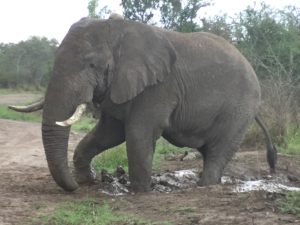
An elephant enjoys a mud bath in Rwanda’s Akagera National Park. Photo by Karen Shigeishi-Waite.
Here’s part II of contributing writer Robert Waite’s riveting account from his trip to Rwanda, following up on his previous post about tracking endangered mountain gorillas in that tiny central African country.
In this post, Bob and his wife, Karen, discover a national park teeming with wildlife (including amorous hippos), a sobering genocide museum, an oddly shaped palace, a “killer” lake, and the “joys” of experiencing a “Rwandan massage.”
By Robert Waite
Kigali, Rwanda – Most people, if they are aware of Rwanda at all, likely only know two things: 1) It is an excellent place to observe the mountain gorilla in its natural habitat and, 2) The country experienced a horrific genocide in the 1990’s. The former inspired the film “Gorillas in the Mist”; the latter, “Hotel Rwanda”. Neither movie had a happy ending.
In truth, this tiny East African nation has much more to offer. As I have previously written, there can be great reward in lingering longer in a single country, rather than rapidly hopping from one to another.
Rwanda is just such a country.
Although small – at 26,338 sq km (about 10,000 sq miles) roughly the size of Massachusetts – the country offers a remarkable amount of variation, from majestic volcanic mountains in the northwest, to an African great lake, Kivu, in the west, to a vibrant National Park, Akagera, in the east. At the very center of the country is Kigali, the capital.
When we arrived in Kigali we were met by our guide, Sam, and immediately headed east towards Akagera. Moving about on Rwanda’s roads is a bit of an adventure in itself – the country’s nickname is “The Land of Ten Thousand Hills” – and you’ll certainly experience the ups and downs that implies. Tunnels are rare and bumps – producing what Sam referred to as the “Rwandan Massage” – are frequent.
Wide Range of Wildlife
Akagera National Park turned out to be a delight. Located on the international border with Tanzania, with which it shares a large lake, 0Ihema, in the south, the park is less trafficked than those you might find in Kenya or South Africa.
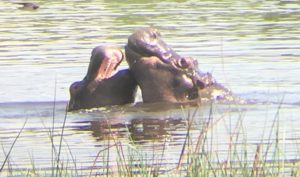
Hippos professing their love for each other in Akagera National Park. Photo by Karen Shigeishi-Waite.
The terrain varies, from swamps and woodlands, to hills and savannah, to the broad lake. This fosters a wide range of wildlife, including hippos, zebras, giraffes, elephants, lions and cape buffalo (not to mention mischievous monkeys, who at our tented lodge merrily pelted us from above with nuts). There are also hundreds of bird species present, including the rare shoebill stork.
Our favorites were the hippos, who frolicked on Hippo Beach and in adjacent waters. You haven’t lived until you’ve seen hippos mate – which they do in shallow water, providing the male with the buoyancy necessary to complete the task.
After a few days at Akagera we made our way back to Kigali, staying at the same “Hotel Rwanda” (the Kempinski Hotel des Mille Colline) made famous by the movie and by UN Mission Chief Gen. Romeo Dallaire’s book, “Shake Hands With the Devil”.
An Unflinching Look at Genocide
Kigali has one must-see sight: the Genocide Memorial. In many ways it provides a lesson in the many ways European colonialism could go horribly wrong.
Rwanda was colonized first by the Germans and then, following WWI, fell under the sway of Belgium. Both countries had a fetish for theories around racial superiority, not only regarding Caucasians, but between the two main Rwandan ethnic groups.
Based on discredited practices — including measuring skull size and shape using calipers — colonial authorities declared that the minority tribe, the Tutsi, were superior to the majority Hutus.
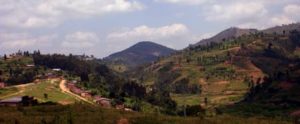
Rwanda’s beautiful rolling hills belie a tragic past. Photo from Kigali Genocide Memorial
For generations the Tutsi were granted preferential status, including access to higher education and jobs in the colonial bureaucracy.
The Hutus, 80 percent of the population, formed a deep resentment which, in 1994, led to a rapid and unchecked wholesale slaughter of Tutsis and those Hutus who tried to come to their aid.
The Memorial tells the genocide story unflinchingly. It also has an adjacent burial area where 250,000 of the estimated 800,000 victims are interred.
Repercussions Remain
The Rwanda genocide has repercussions that last to this day.
Some perpetrators fled the country, but many ultimately faced justice and some who refused to express remorse can still be seen from the road, working in the fields in their orange jumpsuits.
Under the direction of the nation’s president, Paul Kagame, it is now against the law to identify as a Hutu or a Tutsi. As our guide told us, “We are all Rwandans now.”
The other upshot of the genocide, also evident from the road, is the tremendous amount of aid that has poured into the country from around the world. Countries from Canada and the U.S., to Japan, Norway, Israel, China, Sweden, the U.K. and a dozen more, have projects underway to provide clean drinking water, improve agriculture, educate, provide health care, etc.
It’s as if the world is trying to make up for its failure to act when action was needed most. But it has been effective – the country today is relatively prosperous by African standards.
Longhorns, Chimps, and Lakeside Lodges
We continued west from Kigali to Nyabisindu, the site of the former Mwami’s (King’s) Palace. The structure, composed of reeds and straw, looks from the exterior like a beehive. Nearby is a more modern structure, built in the early 20th century after the King visited Brussels and decided to mimic what he saw there.
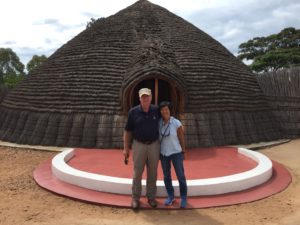
The author and his wife visit the beehive-shaped former King’s Palace.
The most interesting feature, however, is located behind the older palace. It is there you will find the Royal Cattle and the Royal Keeper of the Cattle. These beasts have horns the length of which would make a Texas Longhorn green with envy.
After brief stops in Butare and Huye to visit two excellent museums, we made our way to Nyungwe Forest National Park, known for its active chimpanzee population. Unlike mountain gorillas, which are typically nonchalant when approached by humans, chimps can be quite elusive. This necessitated an early start – 4:30 a.m. – but we were well rewarded, getting within camera distance of several before they scurried off.
Our final destination (prior to heading up to Volcanoes National Park to track gorillas) was Kibuye on the shore of Lake Kivu, formed as part of the Great Rift Valley. The lake is long and deep and best known for a sardine-like fish called the Sambaza – well worth trying.
The first lodge where we stayed, Emeraude Kivu Resort, provided a spectacular view towards the Democratic Republic of the Congo side and an opportunity to fish. The second, Cormoran Lodge, was perched high on a hillside and offered guests kayaking.
Kivu Lake, by the way, is one of Africa’s “Killer Lakes”, so named because beneath its surface lurks 55 billion cubic meters (1.94 trillion cubic feet) of methane gas.
Our guide did not know this, so I showed him the Wikipedia entry. He took a deep breath, looked me in the eye and said, “I hope it doesn’t burp tonight.” It didn’t. And it probably won’t while you are there – but be warned.
On a happier note, some of the methane is currently extracted to run the boilers at Bralirwa, the local brewery.
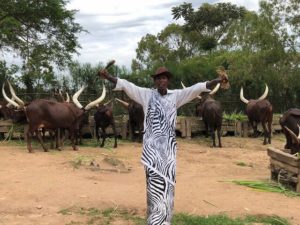
These longhorns would make a Texan envious. Photo by Karen Shigeishi-Waite
In all, including the trip up to Volcanoes National Park and back to Kigali, we ended up covering more than 1,600 km in Sam’s converted Toyota Land Cruiser. That’s a lot of Rwandan massages – but it was worth every bump.
If You Go
Kigali, the Rwandan capital, can be reached by air from Nairobi using Kenyan Airways. We contracted with Cedarberg Africa to make all of our African arrangements and used Primate Safaris as our local Rwandan guide service.
While at Akagera National Park we stayed at Ruzizi Tented Camp and while on the shores of Lake Kivu we stayed one night at Emeraude Kivu Resort and one night further north at Cormoran Lodge in Kibuye. All were excellent.
Author Bio: Robert Waite has written on travel for almost 50 years. A former Pacific News Service correspondent, he is a professor at Seneca College in Toronto and Managing Partner at Waite + Co., a communications consulting firm with offices in Boston, Ottawa and Toronto.
Here are previous adventurous posts by Robert Waite that I recommend:
Haida Gwaii’s Magical Mix of Culture, Adventure
Sailing the Magical Islands of Haida Gwaii












2 Responses to Roaming Around Rwanda